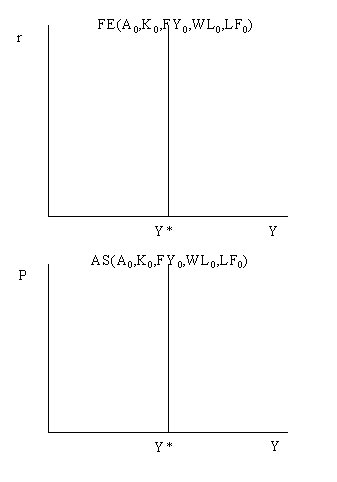
Reading: AB, chapter 11, section 3.
Aggregate supply curve

The aggregate supply (AS) curve is
derived from the full employment (FE)
curve. The AS curve is plotted in a graph
with the aggregate price level on the
vertical axis and output on the horizontal
axis. Recall, the aggregate supply of
output is determined by the interaction
between the production function and the
labor market as summarized by the FE
line. In labor market equilibrium, full
employment output is Y*. Only changes
in the production function or changes in
labor demand or labor supply will change
Y*. Since the production function and
the labor market are not affected by
changes in the aggregate price level (it is
assumed that any change in P is offset by
changes in nominal wages, W, so that the
real wage, W/P, stays constant) the
aggregate supply curve is a vertical line in
the graph with P on the vertical axis and
Y on the horizontal axis.
 The aggregate demand for goods and
services is determined at the intersection
of the IS and LM curves independent of
the aggregate supply of goods and
services (implicitly, when deriving the AD
curve it is assumed that whatever is
demanded can be supplied by the
economy). The AD curve is a plot of the
demand for goods as the general price
level varies. For a given price level, P0,
the IS and LM curves intersect at the
point (r0, Yd0). This intersection point is
plotted in the graph below (as the big
black dot). If the price level increases to
P1 then the LM curve shift up and left and
the new equilibrium is at the point (r1,
Yd1). The higher real interest rate has
decreased the aggregate demand for
goods. This new equilibrium is
represented as the big blue dot on the AD
curve. Similarly, if the price level drops
from P0 to P2 then the LM curve shifts
down and right lowering the real interest
rate and increasing demand. This new
equilibrium is given by the big red dot on
the AD curve.
The aggregate demand for goods and
services is determined at the intersection
of the IS and LM curves independent of
the aggregate supply of goods and
services (implicitly, when deriving the AD
curve it is assumed that whatever is
demanded can be supplied by the
economy). The AD curve is a plot of the
demand for goods as the general price
level varies. For a given price level, P0,
the IS and LM curves intersect at the
point (r0, Yd0). This intersection point is
plotted in the graph below (as the big
black dot). If the price level increases to
P1 then the LM curve shift up and left and
the new equilibrium is at the point (r1,
Yd1). The higher real interest rate has
decreased the aggregate demand for
goods. This new equilibrium is
represented as the big blue dot on the AD
curve. Similarly, if the price level drops
from P0 to P2 then the LM curve shifts
down and right lowering the real interest
rate and increasing demand. This new
equilibrium is given by the big red dot on
the AD curve.
The above graphs shows that the AD curve is a downward sloping function of the general price level. This occurs because a low price level (given a fixed money supply) lowers the real interest rate and stimulates interest sensitive demand.
[Previous Slide] [Contents for Lecture 10] [Slides from Lecture] [301 Homepage]
Last updated on July 24, 1996 by Eric Zivot.